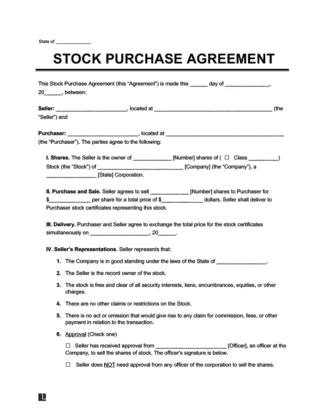
Use our stock purchase agreement to record the purchase of stock and protect the buyer and seller.

Updated January 26, 2024
Written by Sara Hostelley | Reviewed by Brooke Davis
A stock purchase agreement (SPA) is a legal document outlining the terms of a buyer and seller’s transaction of company shares.
A stock purchase agreement or share purchase agreement is a contract a buyer and seller enter to solidify the transfer of company stock.
Most commonly, this agreement is between the company’s shareholders and an external party. The external party may purchase stock from the company or sell it back to the shareholders. Alternatively, this contract may be between two external parties looking to transact company stock that one of them owns.
This agreement strives to protect both parties since it lays out the sale of company shares, their price, and which party is obtaining them.
Purchasing stocks privately typically refers to acquiring shares in private companies or obtaining shares from existing shareholders in a private transaction. Here are the types of stocks someone can purchase privately:
Explore some reasons to use a stock purchase agreement:
This agreement lets sellers raise capital (or other agreed-upon compensation) to fund the development and expansion of their company. You can also use stock as an incentive to draw in highly skilled talent. Offering stock gives you a competitive advantage over other companies that don’t offer stock to reward employees.
Buyers can become partial company owners through this agreement, allowing them to grow their wealth and meet their investing goals. As the company succeeds, buyers can achieve financial benefits for themselves. They can generate dividend income with common stock and profit when they sell their shares back to the company or another external buyer.
This agreement shows proof of the transaction of company shares. Once both parties sign it, the seller can administer a stock certificate to the buyer so the buyer has a representation of their ownership.
An SPA provides a thorough account of the transaction, including the closing date, total purchase price, number of shares the seller is selling, and price per share. These details prevent any confusion or misunderstandings between the parties.
You need a stock purchase agreement if you plan on selling shares of your company. Please use a business purchase agreement if you need to record the sale of a business.
This document gives legal protection to both parties in several ways. For example, it stipulates how to resolve disputes if they arise. It may also outline the right of first refusal, demanding that the buyer offer the company the right to buy back their stock if the buyer wishes to sell their shares one day.
This contract lays out all of the warranties and provisions of the sale. It specifies what conditions both parties must meet for the sale to occur.
The federal and local governments highly regulate stocks, so all share purchase agreements must adhere to the regulations and laws applicable to each sale. The agreement may be invalid if any portion of the contract violates state or federal laws.
Please also ensure all sections are factual. If the representation of the company or stock is false or fraudulent, the agreement will be invalid.
A solid stock purchase agreement constitutes of the following sections:
Define all terms you’ve used in the agreement. For example, you can specify any affiliates you include in the transaction and the nature of the business you’re selling.
Include the buyer’s and seller’s names and addresses. Clarify who each party is.
Define the shares, including how many shares, their type, the company they belong to, and the state where the company operates.
Then, outline the purchase and sale details. Include the number of shares, the price per share, and the total price.
Write the date when the buyer and seller agree to exchange stock certificates.
Have the seller include representations and warranties, such as the following:
In addition to the seller’s representations and warranties, ensure the buyer represents and warrants to the seller any agreed-upon provisions.
The closing conditions will specify the amounts of money that either party needs to distribute at different times to carry out the agreement.
For example, the buyer might owe a specific amount of money as a deposit at closing. They may also need to place a specific amount of money in escrow to secure it for possible breaches of representations or indemnities.
Here are some other clauses to include in a SPA:
Purchasing stock privately involves a different process than buying shares on a public exchange. When you buy privately, you often deal directly with the seller rather than conduct the transaction through a broker.
This process is generally more complex and requires a good understanding of legal and financial matters. Here’s a step-by-step breakdown of how the process typically unfolds:
The first step in purchasing stock involves identifying a seller and negotiating the terms of the sale. This step includes determining the price, the number of shares you want to buy, and other conditions relevant to the transaction.
Once you have a tentative agreement, it’s time to conduct due diligence. Perform thorough research to help you understand the financial, legal, and operational status of the company whose shares you want to purchase.
Review financial statements, reports, and other relevant documents to understand what you might buy into.
The SPA should detail all the transaction terms, including the representations and warranties, indemnification provisions, and any conditions precedent to closing.
Negotiate the terms with the seller and their legal counsel.
Make any necessary revisions until both parties are content with the terms. Obtain both parties’ signatures.
Once you’ve satisfied all conditions, proceed to closing. Pay the purchase price, and the seller will transfer the shares to you.
Secure financing to cover the purchase price and other associated transaction costs if necessary.
Download a stock purchase agreement template in PDF or Word format below: